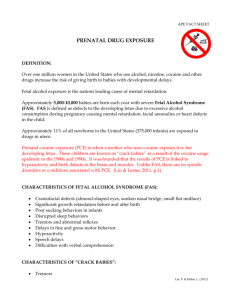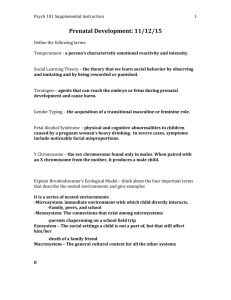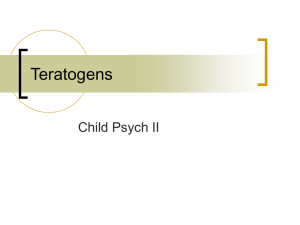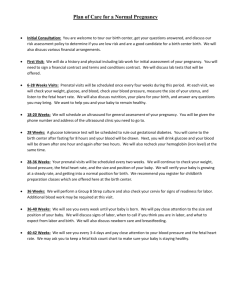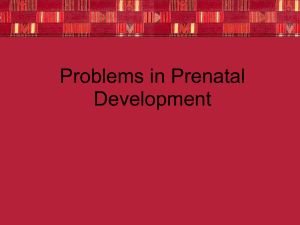Chapter 3: Prenatal Development and Birth
advertisement
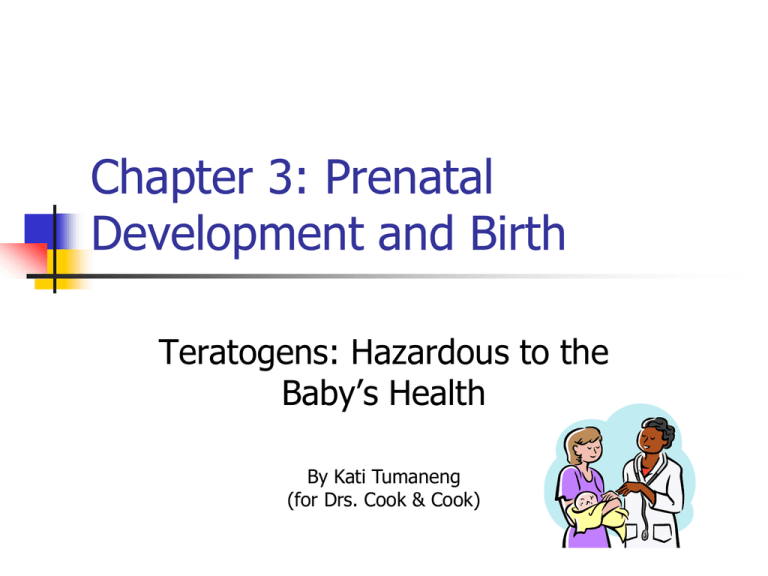
Chapter 3: Prenatal Development and Birth Teratogens: Hazardous to the Baby’s Health By Kati Tumaneng (for Drs. Cook & Cook) Teratogens: Hazardous to the Baby’s Health Most defects occur from unknown causes. 1/3 related to environmental factors during prenatal development. Fetus buffered but not fully protected. Teratogen – Any substance or condition that might disrupt embryonic development and cause birth defects. More info on birth defects from March of Dimes: www.modimes.org/ Alcohol 19% pregnant women drink alcohol during pregnancy. Can cause physical deformities, growth retardation, damage to the central nervous system, and miscarriage and fetal death. Children at greater risk for being impulsive, easily distracted, and hyperactive; having retarded brain growth and lowered IQ. Leading non-genetic cause of mental retardation in US. Alcohol Fetal Alcohol Syndrome (FAS) – Syndrome of birth defects cause by prenatal exposure to alcohol. Includes growth deficiencies, head and facial malformations, and central nervous system dysfunction. Fully preventable. Fetal Alcohol Effects – Individual or multiple birth defects caused by prenatal exposure to alcohol. Lowered IQ, hyperactivity, growth deficiencies, head and facial malformations, and central nervous system dysfunction. There is no safe level of alcohol consumption. Alcohol Child with FAS Cocaine 1 in every 100 pregnant women use cocaine; may be underreported. Fetal exposure retards growth, can cause preterm birth, and can cause malformation in baby’s brain, intestines, and genital-urinary tract; hemorrhage, lesions, and swelling in brain. Increased irritability, muscle tremors, rigidity, decreased spontaneous movement; impaired sensory function, decreased visual attention, and trouble regulating their own state of arousal. Cocaine Cigarette Smoking 12 percent of pregnant women smoke. 450 different harmful chemicals in cigarette smoke. Mother and baby gain less weight; baby more likely to be premature and have health complication. More likely to be hyperactive, have short attention span, and score lower in reading, spelling, and math. Increase risk for spontaneous abortions, stillbirths, and neonatal deaths. Quit Smoking: http://www.hc-sc.gc.ca/hl-vs/tobac-tabac/index_e.html Maternal Diseases Infectious diseases carried by mother, may endanger the fetus. May cause birth defects or death. Herpes Simplex Virus May be transmitted at birth if mother is showing symptoms. Premature, microcephaly, eye disorders, and mental retardation. Cytomegalovirus dangerous, especially during weeks 2-8. STD’s: http://www.niaid.nih.gov/dmid/stds/ Maternal Diseases Syphilis 1 in every 10,000 babies born with Syphilis. Birth defects include deafness, malformations of teeth and bones, facial deformities, excess fluid in the brain, and mental retardation. Prompt treatment of mother may protect baby. HIV/AIDS Effects not yet clear but may include growth retardation and head and facial deformities. Baby usually contracts at or near delivery; infection risk increases with breast-feeding. Maternal Age 900,000 teenagers become pregnant in US each year; nearly ¼ of all births. Risk of low birth weight is highest in mothers under 15 and over 45. Young mothers not socially and cognitively mature enough to cope with stress in early pregnancy. Factors associated with teenage pregnancy: Low income, poor education, social isolation, drug and alcohol use, lack of early prenatal care. Maternal Age Maternal Age Women in late 30’s and into 40’s have greater risk of prematurity, fetal death, and complications during birth. Increased risk of Down Syndrome. Even with increased risk, majority of pregnancies are normal. Critical Periods Segments of time when structures are first. forming and are most vulnerable to damage. Developing organism is at greatest risk for abnormalities during the Embryonic stage (weeks 3-8). Women not often sure of pregnancy before 8th week. Lifestyle changes then may be too late. Critical Periods What about Fathers? When toxic substances affect sperm cells, the damaged sperm usually do not survive journey to the egg. Cocaine may disrupt development of zygote. Most birth defects result from mother’s exposure to toxins. Men should consider how they contribute to prenatal hazards. Healthy pregnancy is the responsibility of both men and women. Child on Slide 5: from Cook, J. L., & Cook, G. (2005). Child development: Principles and perspectives (1st ed.) (p. 97). Boston: Allyn and Bacon. Infant on Slide 7: from Cook, J. L., & Cook, G. (2005). Child development: Principles and perspectives (1st ed.) (p. 98). Boston: Allyn and Bacon. Chart on Slide 12: from Cook, J. L., & Cook, G. (2005). Child development: Principles and perspectives (1st ed.) (p. 101). Boston: Allyn and Bacon. Chart on Slide 15: from Cook, J. L., & Cook, G. (2005). Child development: Principles and perspectives (1st ed.) (p. 103). Boston: Allyn and Bacon. All images retrieved from Microsoft PowerPoint Clip Art.
